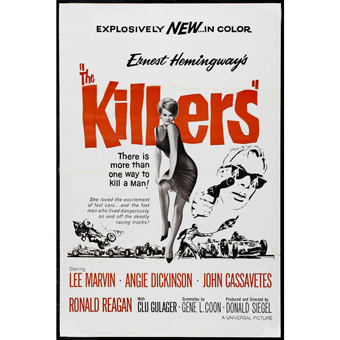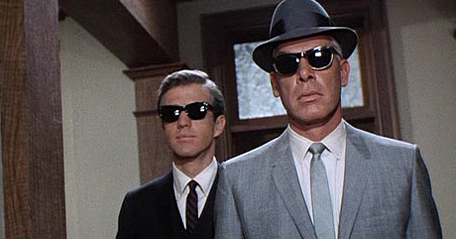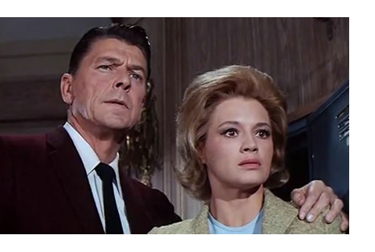
 |
|
|
|
Universal released two film versions of Ernest Hemingway's The Killers, separated by eighteen years. The first is a B&W noir classic which introduced audiences to Burt Lancaster, and boosted Ava Gardner to star status. The second is a cult item filmed for TV but given the boost to theaters because of its violent subject matter. Criterion released its first DVD disc set pairing the two features back in 2003; now they're reissuing them in a similar package with much improved transfers. So what we have are two pictures from different eras adapted from the same Ernest Hemingway short story, a one-act bit of anguish where a pair of hit men terrorize a lunch counter before rubbing out their appointed victim. Each film expands the brief, chilling fragment into a dark thriller told in retrospective flashbacks. Together they chart the evolution of Film Noir from romantic fatalism to existential nihilism.
|
|
Director Robert Siodmak and producer Mark Hellinger put together a corker of a story in the first screen iteration of The Killers. To expand Hemingway's short story into a full feature, Anthony Veiller, Richard Brooks and John Huston introduce a Citizen Kane-like flashback structure, telling the story of a crime through multiple character testimony. The inverted narrative begins with a fated conclusion, and jogs back to the beginning. We watch boxer Andersen struggle to put his hands on stolen money and a gangster's unfaithful girl friend, knowing he'll lose both. The story is basic Loser Noir, albeit between very attractive losers. 
The flashback structure illuminates the story rather than simply complicating it. Insurance investigator Jim Reardon Edmond O'Brien) doggedly pursues the mystery behind the gangland-style hit placed on Ole Anderson (Burt Lancaster), a moody gas pump boy. Instead of running, Ole calmly allowed himself to be gunned down. When Reardon uncovers the truth about Anderson's crooked dealings with femme fatale Kitty Collins (Ava Gardner) and crook Big Jim Colfax (Albert Dekker), he puts his own life in jeopardy. The fated flashback structure had worked well in Double Indemnity and Detour. But in this story the protagonist is already dead, which lends a poignant aspect to his love for Kitty Collins, and a pallor of doom overall. As in Kane, an investigator interviews witnesses to piece the story together. The testimony cues a number of deeply felt scenes that tell us more than what Reardon must be hearing -- the erotic spell Kitty places over Ole, his desperate entanglement in a multi-leveled double-cross. There's even a set piece showing a daring daylight factory robbery filmed in one long and complicated crane shot. Reardon uncovers the truth about who cheated who, but only we are privy to the lush narrative vision of Ole's downfall. The whole show is bathed in pools of darkness and light ruled by Woody Bredell's chiaroscuro lighting. The opening scene is a static angle past two mysterious men from the back seat of a car speeding in the night, a key noir visual that would be repeated in Out of the Past, Kiss Me Deadly, On Dangerous Ground, In a Lonely Place, and later referenced in Taxi Driver. The obsessive, destructive love of Ole for Kitty was already a noir staple, and would be further elaborated in Siodmak's followup with Lancaster, Criss Cross, a story about similarly doomed characters. But the pairing of Lancaster and Gardner generated real sparks, as beefy Burt's attraction for Ava's toxic beauty comes right through the screen. |
|||||||||||||||||||||||||||

|
The Killers 1964 / Color / 1:37 flat / 93 min. / Ernest Hemingway's The Killers Starring Lee Marvin, Angie Dickinson, John Cassavetes, Clu Gulager, Claude Akins, Norman Fell, Ronald Reagan Cinematography Richard L. Rawlings Art directors Frank Arrigo, George Chan Editor Richard Belding Original Music Johnny Williams, Henry Mancini, Don Raye Written by Gene L. Coon Produced and Directed by Donald Siegel |
When hit men Charlie Strom (Lee Marvin) and Lee (Clu Gulager) rub out their contract target Johnny North (John Cassavetes), the auto shop teacher passively accepts his fate. Charlie is so intrigued by this that he and Lee crisscross the country to figure out North's back story, both to profit from whatever crime their victim was a part of, but also to quench Charlie's curiosity. They find that North, a former racecar driver, was lured into a robbery caper with big crook Big Jack Browning (Ronald Reagan) by Browning's own girlfriend, Sheila Farr (Angie Dickinson).
Writers on Film Noir love the contrast between these two film versions, and happily chart their essential differences. In the fifties, the low-key darkness of Noir gave way to the greys of naturalistic daylight and drab location-filming reality, and the elaborate romances and convoluted, frequently absurd plot structures of the early films became more straightforward exercises in iconic structures and minimalist plotting. (Whew!) Fritz Lang's last Hollywood films were Noir thrillers set against generic backgrounds. Pictures like The Brothers Rico were more about defining the essentials of what a mobster was, instead of what he did.

The hit men of the earlier film were a scary but marginal threat, who spent most of the running time lurking somewhere off screen. In this 1964 remake, the hit men are the ones who do the investigating. Charlie and Lee are our protagonists, and the cops are almost completely absent. We watch the two killers terrorize innocent people for information. They're just like Al and Max, with the essential difference of added expedience. Al and Max took their time, playing sadistically with their captives like cats with a mouse; it really didn't matter if they got their information before or after they ate. In the hepped-up, speed-obsessed Go-Go Sixties, Charlie and Lee just don't have the time to mess around. Rudely cornering their prey, they immediately go for the hard sell, whether it means dangling a woman from a high window by her legs, or terrorizing a helpless blind lady.
The mystery Charlie and Lee uncover is essentially the same as the caper from the earlier film, changed to accommodate a car racing background. Instead of a stationary factory, the robbery objective is a moving mail truck. The bait is not an old-fashioned sultry siren, as with femme fatale Ava Gardner. Poor fool John Cassavetes falls for the obvious good time girl Angie Dickinson, whose insincere outer level peels off to reveal just more layers of insincerity. Johnny North 'dies' not once but three times. In an early car wreck, the shot where he walks away from the obviously fatal stock shot crash is unintentionally funny. North 'dies' yet again when Angie sells him out to her main man, Ronald Reagan. Seeing Reagan play a brutal louse is the soul of wish fulfillment. I have to think that Siegel did that on purpose.

Lee Marvin nails the buttoned-down patter that Charlie lays on his victims, defining the shark-like star persona he'd keep for the next two decades. He's often pictured squint- aiming a pistol appended with one of those enormous silencers attached to the barrel, an image that gives the gun equal graphic emphasis. Clu Gulager affects a giggling hipster cruel streak, primping like Ed 'Kookie' Byrnes of 77 Sunset Strip (snap-snap) in a way that hasn't aged well. Lee comes off as the weak sister to Marvin's cold menace, sort of a hit man's Sancho Panza. There were some notable hit man teams in earlier noirs (especially the covert gay pair from 1955's The Big Combo), but Charlie and Lee are arguably the model for Quentin Tarantino's chatty, funny killers in his later Pulp Fiction.
Angie Dickinson, the modern man's woman from Rio Bravo and China Gate, is here given the sensible name Sheila Farr instead of the fetishistic 'Lucky Legs', or 'Feathers'. Her essential toughness would later make her the perfect mobster's foil when she reunited with Marvin in the cosmic revenge tale Point Blank. John Cassavetes is likely on board just to pay the bills for his own experimental independent productions, but he contributes his reliable intensity. He even got his Faces star Seymour Cassell into the movie to play a fast bit part.

But the big coup was casting the semi-retired Ronald Reagan. As rigid as a washboard, Reagan's last film has him playing Big Jack Browning as a one-dimensional heavy. The gangster crook has no redeeming qualities whatsoever, a combination he would carry to the state capitol as Governor two years later. The absurdity of 1970 college life never got more absurd as when we'd be dodging Reagan's national Guardsmen one day, and then the next day see the Drugstore Truck-Driving Man himself in a film school screening, back-handing Angie Dickinson across a room. It's a classic piece of film, just on content alone. Burt Bacharach's woman is knocked for a loop, hair flying, and our cool liberal Cassavetes, Machine Gun McCain himself, decks Reagan with a retaliatory right cross. Utterly priceless. This got standing ovations back at UCLA.
Lovely Virginia Christine, who plays a charming cop's wife in the original, comes back in this remake in the brief role of the blind lady terrorized by Lee Marvin. Her television fame as the Folger's coffee lady only adds to the cruelty of the scene.
The remake of The Killers has an archetypal Sixties' finale, with (spoiler) Lee Marvin collapsing in a stupor on the sunny green lawn of a new-looking suburban development. He clutches the suitcase with the cash, for which so many have died. It's an instant cliché, but effective nonetheless, especially with Marvin's cocky final gesture at the cops. It's one of director Don Siegel's (Dirty Harry) finest moments.
The Criterion Collection's Blu-ray of The Killers '46 is a major improvement, with a sharper, cleaner scan of better elements. The inky blacks make it look as if the hit men live in dark shadows. Ava Gardner's close-ups transformed her from just another MGM contractee, to a top looker highly in demand. The aura generated around her fabled love life did the rest.
The extras are extensive (see below), with the standout being the 1956 Andrei Tarkovsky student version of the short story, which follows Hemingway even more closely than did Siodmak. There's also a 1949 radio play version with Shelly Winters and Burt Lancaster, where we can hear Siodmak describing The Killers with the same words used by later Noir critics. Stacy Keach recites the short story for another feature. Not included this time around is the Paul Schrader essay that effectively launched Noir fever in America, when it was used as a pamphlet for a 1972 Filmex marathon.
The Criterion Collection's Blu-ray of The Killers '64 is a big improvement on the 2003 release; now it looks like a real movie, with good color and sharp detail. It started out as a TV movie (supposedly the first) but got bumped to the big screen after JFK was assassinated. We see more than one scene in which a sniper picks off a victim at long range. One man is gunned down in a setup staged identically to a killing in 1931's The Public Enemy.
The transfer is flat, which is not the original aspect ratio for a film initially released to the big screen. Although planned for TV, the movie was composed for theatrical widescreen use, as TV movies (and some series, re-edited TV series) of the time were commonly distributed theatrically in Europe. The English company Arrow Films' Region B Blu-ray disc contains both a flat transfer and one matted off to 1:78 widescreen. I know that a 'controversy' boils up every time someone says an Aspect Ratio is correct because they first saw the movie that way, or it just feels good. Frankly, in widescreen the compositions look much better, eliminating dead space, often occupied by unconvincing back projection.
The extras for the second version begin with excerpts from Don Siegel's autobiography. The video interview from 2003 is a 'reflection' from actor Clu Gulager, shot by his sons in an annoying style that dissolves back and forth between two DV cameras. We concede that prime-source talk about forty year-old movies is not easy to come by.

On a scale of Excellent, Good, Fair, and Poor,
The Killers '46 & The Killers '64 Blu-ray
rates:
Movies: Excellent
Video: Excellent
Sound: Excellent
Supplements: Andrei Tarkovsky's short film adaptation from film school, 2002 Stuart M. Kaminsky; Stacy Keach 2002 short story recital; radio adaptation from 1949; Clu Gulager interview from 2002, Hampton Fancher reads from Don Siegel's autobio, Trailers, insert essays by novelist Jonathan Lethem and critic Geoffrey O'Brien.
Deaf and Hearing-impaired Friendly?
YES; Subtitles: English
Packaging: One Blu-ray in keep case
Reviewed: July 1, 2015

Review Staff | About DVD Talk | Newsletter Subscribe | Join DVD Talk Forum
Copyright © MH Sub I, LLC dba Internet Brands. | Privacy Policy
Subscribe to DVDTalk's Newsletters
|